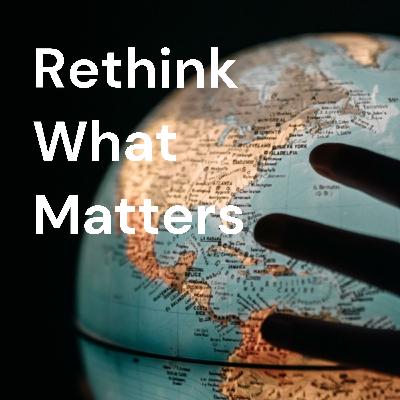Discover Rethink What Matters
Rethink What Matters

Rethink What Matters
Author: Paul Freudenberg of Rostone Operations
Subscribed: 1Played: 4Subscribe
Share
© Paul Freudenberg of Rostone Operations
Description
We need to rethink what matters in our lives and in business if we are to address today’s climate and cost of living challenges, low levels of productivity and happiness, health and well-being. It’s a positive, fun and engaging podcast with a serious purpose. Join in, help make a difference or get in touch at awardaroo.io
39 Episodes
Reverse
Rethink What Matters: Material Passports and the Circular Built EnvironmentIn this episode of Rethink What Matters, we welcome Andrea Charlson from Madaster, a pioneering platform focused on enabling a circular built environment through the use of material passports. Together, we explore how data, transparency, and new ways of thinking about materials can reshape the construction industry—and why this matters now more than ever.Buildings are filled with valuable materials, but traditionally, we haven’t kept track of them. Madaster is changing that. By giving every product and material in a building a digital identity—detailing what it is, where it came from, and what can be done with it at the end of its life—we unlock the potential to reuse, resell, or repurpose rather than send things to landfill. This isn’t just good for the planet; it’s smart business.Andrea shares how material passports are gaining traction, especially with tenants, who recognise that interior fit-outs like furniture, finishes, and equipment often have much shorter lifespans than the building’s core. With this data in hand, they can plan upgrades and replacements more intelligently, while reducing waste and cost. It's a compelling value proposition that links sustainability directly to day-to-day decisions.We also discuss Madaster’s integration with BIM (Building Information Modelling), making it easier to generate passports during design and construction. This allows owners, designers, contractors, and even product manufacturers to align on shared, structured data—data that can drive everything from carbon reporting to reuse strategies and residual value estimation.From pilot projects like British Land’s 1 Broadgate to broader regulatory support through London’s circular economy planning requirements and the EU taxonomy, the circular economy is moving from theory to practice. But challenges remain: how do we keep material data up to date over decades? Who owns it? And how do we embed it into everyday property management?Andrea highlights that real transformation will come not just from better materials or smarter tools, but from new business models—ones where ownership, leasing, and take-back schemes are part of the product journey from day one.Whether you’re in property, construction, design, or sustainability, this episode will help you understand how material passports can deliver business value, environmental benefits, and long-term asset resilience. Welcome to the future of buildings—one where nothing goes to waste.
ESG (Environmental, Social, and Governance) principles are increasingly becoming central considerations in the design and construction of built environments. This paradigm shift reflects a growing recognition of the interconnectedness between human activities, the environment, and societal well-being. ESG design in the built environment seeks to integrate sustainability, social equity, and ethical governance practices into every stage of a project's lifecycle.At its core, ESG design emphasises environmental stewardship by minimising resource consumption, reducing carbon emissions, and preserving ecosystems. Architects and urban planners are incorporating passive design strategies, renewable energy systems, and green infrastructure to mitigate the environmental impact of buildings and communities. This approach not only promotes ecological resilience but also enhances the quality of life for occupants.Social considerations are integral to ESG design, addressing issues of inclusivity, accessibility, and community engagement. Designers strive to create spaces that are welcoming, safe, and conducive to social interaction, catering to diverse needs and demographics. This involves prioritising equitable access to amenities, public transportation, and green spaces, fostering a sense of belonging and cohesion within neighborhoods.Moreover, governance principles play a crucial role in ensuring transparency, accountability, and ethical conduct throughout the development process. Stakeholder engagement, ethical sourcing of materials, and adherence to regulatory standards are fundamental aspects of ESG design and construction practices.
Energy storage solutions play a pivotal role in modernising our energy infrastructure. These systems store excess electricity generated during periods of low demand and release it when demand surges or renewable sources like solar and wind are unavailable. Lithium-ion batteries, pumped hydro storage, and emerging technologies like solid-state batteries and flywheels are some examples. Energy storage enhances grid reliability, mitigates energy intermittency issues, and facilitates the transition to clean, sustainable energy sources, ultimately reducing greenhouse gas emissions and ensuring a more resilient energy ecosystem.
Sustainable economies are the cornerstone of a prosperousand responsible future. They prioritise the careful management of naturalresources, fostering environmental stewardship and social equity. Such economies seek to balance economic growth withenvironmental preservation, promoting renewable energy, circular production,and reduced waste. In sustainable economies, businesses adopt ethicalpractices, embracing fair wages and responsible supply chains. Communities benefit from improved public transportation andgreen infrastructure, enhancing quality of life. Moreover, sustainable economies prioritise education andinnovation, nurturing a skilled workforce to drive forward eco-friendlyindustries. By promoting long-term well-being over short-term gains,sustainable economies pave the way for a more equitable and resilient world.https://kageadvisory.com/
Greening cities is a vital strategy in the face of urbanisationand climate change. It involves implementing sustainable practices to enhancethe environmental quality of urban areas. By expanding green spaces, plantingtrees, and creating urban gardens, cities can mitigate heat islands, improveair quality, and provide recreational spaces for residents.Green roofs and walls reduce energy consumption by insulatingbuildings and absorbing rainwater, reducing the strain on drainage systems.Encouraging public transportation, cycling, and walking also reduces carbonemissions. Furthermore, sustainable urban planning can promote biodiversity,creating habitats for wildlife. In essence, greening cities is not onlyaesthetically pleasing but also a practical approach to fostering healthier,more sustainable, and resilient urban environments.https://www.wildfifteen.com/
Biomimicry, often hailed as nature's blueprint for innovation, is a design approach that draws inspiration from the natural world to solve human challenges. It involves emulating the ingenious solutions that have evolved in various species over millions of years. From Velcro inspired by burrs to efficient wind turbine designs influenced by humpback whale fins, biomimicry showcases how nature's designs can inform and revolutionise human technology.
Electric scooter rentals have revolutionised urban mobility. These convenient, eco-friendly vehicles offer a quick and sustainable solution to short-distance travel. Users can easily locate and rent electric scooters through smartphone apps, making them an ideal choice for last-mile commuting, reducing traffic congestion, and lowering carbon emissions. With their affordability and accessibility, EV scooter rentals have gained immense popularity in cities worldwide.https://eva2z.in/
Integrated solar green roofs combine the benefits of green roofing and solar energy generation, offering a sustainable and multifunctional solution. These innovative systems incorporate solar panels seamlessly into green roofs, creating aesthetically pleasing, eco-friendly structures. They harness solar energy to power homes or buildings while promoting environmental sustainability. Green roofs feature vegetation that improves air quality, reduces urban heat islands, and enhances insulation, reducing energy consumption. Simultaneously, integrated solar panels harness sunlight to generate clean electricity. By merging these technologies, integrated solar green roofs optimise space utilisation and environmental benefits.https://urbanstrong.com
Biophilic Cities seamlessly integrate nature into urban environments, fostering a deep connection between humans and the natural world. Through green spaces, biodiversity corridors, and architectural designs inspired by nature, these cities prioritise well-being, sustainability, and resilience. Residents enjoy improved mental and physical health, reduced stress, and increased creativity in these urban oases.
Microfinance plays a crucial role in alleviating poverty by providing financial services to the underserved and financially excluded populations. By offering small loans, savings accounts, and insurance products, microfinance empowers individuals to start or expand small businesses, improve their livelihoods, and gain economic independence. These financial tools allow people to access capital that might otherwise be unavailable, breaking the cycle of poverty. Moreover, microfinance institutions often prioritise women as recipients, promoting gender equality and enabling women to contribute to their families' and communities' economic well-being. In this way, microfinance acts as a catalyst for sustainable development and poverty reduction.
Ocean plastic pollution poses a grave ecological threat, imperiling marine life and ecosystems. An estimated 8 million tons of plastic enter the oceans annually, enduring for centuries and disintegrating into microplastics that pervade the food chain. Seabirds, turtles, and marine mammals ingest or become entangled in plastic debris, suffering injury or death. Beyond its visible impacts, plastic pollution disrupts oceanic habitats and exacerbates climate change by releasing harmful chemicals. Mitigation demands global cooperation, including reduced plastic production, improved waste management, and heightened public awareness. Preserving the oceans necessitates concerted efforts to stem this tide of plastic contamination.
ESG (Environmental, Social, and Governance) and SDG (Sustainable Development Goals) Impact Assessments gauge the effects of business activities on broader societal and environmental objectives. ESG focuses on a company's ethical practices, its impact on the environment, and the quality of its governance. SDGs are global sustainability targets. Assessments involve data collection, analysis, and reporting, enabling organisations to align their strategies with sustainable practices.
Green hydrogen, derived from renewable sources via electrolysis, is a clean, versatile fuel with potential to decarbonise sectors like transportation and industry. Despite challenges, its capacity to mitigate climate change makes it a pivotal player in future sustainable energy systems.
Solar panels, also known as photovoltaic panels, are devices that convert sunlight into electricity. They are a cornerstone of renewable energy systems, harnessing the sun's energy to generate clean and sustainable power. Solar panels consist of interconnected solar cells made from semiconductor materials like silicon. When sunlight hits these cells, it excites electrons, creating an electric current that can be harnessed for various applications. Solar panels are widely used in residential, commercial, and industrial settings to offset electricity consumption and reduce carbon emissions. Their adoption contributes to energy independence, lower utility bills, and a greener planet by reducing reliance on fossil fuels.
Ecotourism, a sustainable travel trend, harmonises exploration with nature preservation. It encourages responsible travel, fostering environmental awareness and local community engagement. Emphasising education and minimal impact, ecotourism promotes wildlife conservation and supports socioeconomic development.
Marine conservation is vital to safeguard Earth's oceans, preserving their biodiversity, ecosystems, and the services they provide. Overfishing, habitat destruction, pollution, and climate change threaten marine life. Conservation efforts involve creating marine protected areas, enforcing sustainable fishing practices, reducing plastic waste, and mitigating climate impacts.
Sustainability rating platforms are valuable tools that assess and communicate the environmental, social, and governance (ESG) performance of companies and organisations. These platforms utilise comprehensive data and criteria to evaluate factors such as carbon footprint, resource efficiency, labour practices, and ethical governance. By assigning scores or rankings, these platforms empower consumers, investors, and stakeholders to make informed decisions and support sustainable businesses.
Peace, justice, and strong institutions are the cornerstones of a harmonious and equitable society. Peace fosters an environment of stability, where conflicts are resolved through dialogue and diplomacy, rather than violence. Justice ensures that all individuals are treated fairly, regardless of their background or status, and that their rights are protected. Strong institutions are essential for upholding the rule of law, promoting transparency, and providing access to essential services for all citizens.
Good health and well-being are fundamental pillars of a fulfilling and productive life. Achieving optimal physical, mental, and emotional health empowers individuals to lead a balanced and meaningful existence. Regular exercise, a nutritious diet, and sufficient rest contribute to physical wellness, while addressing mental and emotional needs through mindfulness and stress management enhances overall well-being.
Permaculture, short for "permanent agriculture" or "permanent culture," is a holistic approach to designing sustainable systems that mimic the patterns found in nature. Developed in the 1970s by Bill Mollison and David Holmgren, permaculture aims to create self-sufficient and regenerative environments by integrating diverse elements like plants, animals, water, energy, and people.






